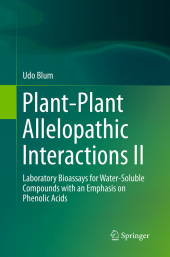 Neuerscheinungen 2016Stand: 2020-02-01 |
Schnellsuche
ISBN/Stichwort/Autor
|
Herderstraße 10
10625 Berlin
Tel.: 030 315 714 16
Fax 030 315 714 14
info@buchspektrum.de |

Udo Blum
Plant-Plant Allelopathic Interactions II
Laboratory Bioassays for Water-Soluble Compounds with an Emphasis on Phenolic Acids
Softcover reprint of the original 1st ed. 2014. 2016. xxi, 322 S. 27 SW-Abb. 235 mm
Verlag/Jahr: SPRINGER, BERLIN; SPRINGER INTERNATIONAL PUBLISHING 2016
ISBN: 3-319-34642-3 (3319346423)
Neue ISBN: 978-3-319-34642-7 (9783319346427)
Preis und Lieferzeit: Bitte klicken
This volume explores laboratory bioassays used to study the roles of water-soluble compounds in plant-plant allelopathic interactions. It provides blue prints for designing more field-relevant screening and cause and effect laboratory bioassays.
This volume presents detailed descriptions and analyses of the underlying features, issues and suppositions associated with seed and seedling laboratory bioassays presented in a previous volume. It is, however, broader in scope and substance in that the information provided is relevant to all water-soluble compounds released to soil by putative allelopathic living plants and their litter and residues. It is ultimately an attempt to update and expand the practical guidelines for designing laboratory bioassays that have previously been provided in the literature with the hope that the designs of future seed and seedling laboratory bioassays will become more relevant to field systems. Standard references have been included to provide background and additional details. This volume has been written specifically for researchers and their graduate students who are interested in studying plant-plant allelopathic interactions.
1 Background for Designing Laboratory Bioassays
1.1 Introduction
1.2 Allelopathic Interactions
1.3 Nature of Allelopathic Compounds
1.4 Sources of Allelopathic Compounds and Modifiers in Soils
1.5 Holism and Reductionism
1.6 Benefits and Limits of Laboratory Bioassays
1.7 False Assumptions and Misconceptions for Laboratory Bioassays
1.8 References
2 Introduction to the Fundamentals of Laboratory Bioassays
2.1 Factors of Bioassay Systems
2.2 Basic Information Required for All Bioassay Systems
2.3 References
3 Some Issues and Challenges When Designing Laboratory Bioassays
3.1 Introduction
3.2 Treatment Concentrations
3.3 Field Inputs and Laboratory Treatments of Water-Soluble Compounds
3.4 Mobility and Proximity of Compounds in Soil Media
3.5 Seed and Seedling Densities
3.6 Symbiotic Relationships
3.7 Soil Microorganisms (Microflora and Fauna)
3.8 Herbivory and Disease
3.9 Physicochemical Environments
3.10 References or Controls
3.11 Measurements
3.12 Final Comments
3.13 References4 Hypothetical Standard Screening Bioassays
4.1 Introduction
4.2 Living Plants
4.3 Plant Litter and Residues
4.4 Field Soils
4.5 Final Comments
4.6 References
5 Effects, Modifiers, and Modes of Action of Allelopathic Compounds Using Phenolic Acids as Model Compounds
5.1 Introduction
5.2 Individual Compounds
5.3 Simple Mixtures
5.4 Complex Mixtures
5.5 Modes of Action
5.6 Final Comments
5.7 References
6 Hypothetical Cause and Effect Bioassays
6.1 Introduction
6.2 Identified Putative Allelopathic (IPA) Organic Compounds
6.3 Complex Solutions
6.4 Using Regression Analyses to Relate Potential Causes with Effects
6.5 Treatment Surface Areas
6.6 Using Omics Methods as Tools
6.7 References
7 Laboratory Model Systems and Field Systems: Some Final Thoughts
7.1 Introduction
7.2 Comparison of Field and Present Laboratory Model Systems
7.3 Is the Present Criticism by Critics Regarding Plant-Plant Allelopathic Interactions in the Field Credible?
7.4 Improving the Value of Laboratory Bioassay Systems
7.5 Future Directions: Questions that Need Answers
7.6 Central Tenets (i.e., Opinions, Doctrines, or Principles) Articulated in this Volume
7.7 Final Comments
7.8 References
Author Index
Subject Index


